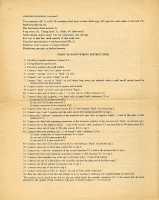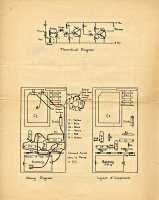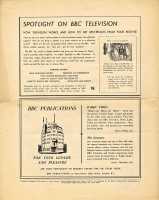
|

|

|

|

|

|

|

|

|

|

|

|

|

|

|

|
Hover your mouse over the
navigation buttons above for
brief page contents.
Pages marked > give access to
one or more subsidiary pages -
see also Site Map at bottom
of WELCOME page.
|
|
|
General points
The leaflet is a single sheet, about 19.7 x 12.4 inches, folded to form a four-page
leaflet about 9.8 x 12.4 inches. The front page carries the Written Archive
Centre's handwritten unique identifier. It also carries the date 23 March 1959,
when the series proper began following the appetiser programme on 9 March. The
first three pages of the leaflet contain all the information for the transistor set
(see below). Page 4 contains two advertisements - of great period appeal -
for BBC publications.
The upper advertisement is for a 1959 booklet entitled Spotlight on BBC
Television, which contained several cartoons by "Artie". Arthur (Artie)
Jackson (c1910 - c1975) became well known for his topical cartoons for the Daily
Express. The advert includes one of the cartoons from the booklet,
Artie’s light-hearted take on the problem of poor reception due to reflected
signals (ghosting). Entitled "Ghosts are often troublesome", it shows the
man of the house entering the darkened tv room to discover two ghosts watching
television!
When I first applied in late 2011 for permission to reproduce the leaflet, the BBC was
happy to allow me to reproduce the three pages containing Davey's design details, but was
uncertain of its re-use rights in this cartoon, and therefore could not allow me to
reproduce the page containing the advert unless this concern could be resolved.
My initial efforts failed to make progress on this. In January 2014,
a member of Arthur Jackson's family contacted me having visited this site, and put me in
touch with his executor, Mr David Jackson, who has kindly given me
permission to reproduce the cartoon. The BBC has, in turn, allowed me to reproduce
the fourth page of the leaflet. I am most grateful to David Jackson and
the BBC for enabling me to reproduce the leaflet in its entirety for you to enjoy.
The circuit and practical layout
As mentioned on THE BBC SETS > page, Gilbert Davey had
relaxed his early reservations regarding transistors for the amateur constructor,
and had published transistor radio designs in the January and October 1957 editions
of Boy's Own Paper. The Focus design has some similarities
to the second of these designs.
The Repanco DRR2 coil specified for the Focus set was designed for valve
sets with reaction, and has long-wave, medium-wave (tapped) and reaction windings.
For this design, the reaction winding is used as an aperiodic aerial winding.
It was in plentiful supply then, but is hard to find now. The signal
to the crystal diode detector is taken from the medium-wave tapping. A
wavechange switch is shown as optional on the coil wiring diagram, but is not
included in the components list. A short aerial wire was suggested.
Gilbert Davey would have been well aware that a simple crystal "front end" like this
would have poor selectivity, especially as compared with the regenerative one-valver
of the previous BBC series. Better results can be obtained with a crystal detector
by using more sophisticated bandpass tuning arrangements, but these usually involve multiple
coils and, ideally, ganged tuning capacitors. An alternative might have been a reflex
design, but this is again more complex and requires a radio-frequency transistor - no doubt
an expensive item in 1959.
Two stages of audio amplification follow the detector. As an indication of Davey's
progress on the transistor learning curve since the October 1957 BOP design,
the base biasing resistors are of higher values than in the earlier design, for longer
battery life. However, both stages are in grounded-emitter configuration, without emitter
resistors or bypass capacitors. According to my understanding, this arrangement
means that stage gain is very dependent upon the variable properties of individual
transistors (Hfe for OC71 quoted as 30 – 110).
Davey had included these emitter circuit components in the October 1957 BOP
design mentioned above, and also in that in Chapter 14 of Fun with Radio,
second edition, published in 1959 and thus roughly contemporary with the Focus
series. So it is puzzling that he omitted them from the Focus receiver.
When the series was aired, he might perhaps have told viewers how to retro-fit
these components, but this could have spelled confusion for young constructors.
(To compound the mystery, Davey again omitted these components from the transistor
design published in BOP April 1961.)
We must conclude that it was decided to go for a simple design with moderate overall cost
for first-time constructors. The appeal of the series would have lain in the novelty
of transistors, and the small size and portability (compared with a valve set) that even an
inexperienced constructor could achieve.
For headphones, the leaflet specifies "any type, or deaf-aid earpiece".
This is a little vague, given that maximum collector current for an OC71 is 10mA,
and the impedance of some hearing-aid earpieces is as low as 160 ohms.
Perhaps during the programmes advice was given on choice of phones or earpiece.
The specified PP4 (or type 226) 9-volt zinc-carbon battery had a cylindrical body,
41.5mm long x 25.8mm diameter, with a snap connector at each end, giving total
length 49.8mm. Its diameter would have set the minimum overall thickness of
the finished set. The PP4 was quickly superseded by the ubiquitous PP3, and is
now unobtainable on the High Street, but for anyone rebuilding the set and wishing
to use a battery similar to that specified, an alkaline version is available from the
Small Battery Company - see:
http://www.smallbattery.company.org.uk/sbc_226.htm
Construction on the suggested 2 3/4 x 5 1/4 inch baseboard is as a simple hook-up,
with the wiring all on one side. No mounting arrangement for the coil is
shown; perhaps a simple bent bracket was described during the programmes.
As the stories below attest, the design's limited performance does not seem to have detracted
from the enjoyment and sense of achievement of those who built it. Housed in a suitable
case, with an aerial lead and projecting tuning knob and wavechange switch (if used), the set
just about qualifies as pocket-size. But those who built it, then showed it off at
school or summer camp when the transistor was still a novelty, would surely have found that
it was an object of wonder and envy!
I have now built this little set, and you can see pictures and further comments
about its construction and performance on the
My Focus Set page.
The images
These images are BBC copyright, and available for your personal non-commercial use only.
Please also read the copyright notice on the WELCOME
page. If you wish to pass them on to a friend, please send a link to this web page.
He will then have access to the viewing and printing suggestions as below.
The images are available below in two forms:
 PDF file: (You need Acrobat Reader installed on your PC.) File size is
now 2.2Mb (larger than formerly in order to do justice to the cartoon), and a broadband
connection is recommended.
PDF file: (You need Acrobat Reader installed on your PC.) File size is
now 2.2Mb (larger than formerly in order to do justice to the cartoon), and a broadband
connection is recommended.
Click the icon to download the PDF file. If Acrobat Reader opens
within your browser, use the "Back" button to return to this page when download is
complete. If Acrobat Reader opens in a separate window, close that window to
return to this page.
All four images are positioned within a PDF file so that when printed on one sheet of
A3 paper, the pages appear in order (page 1 and 4 on one side; pages 2 and 3 on the
other). The original leaflet is somewhat larger than A3, so the PDF file
has been scaled down to fit within this size, yielding a leaflet around 80% (linear)
of true size. Having printed the file on to A3 paper, you can then trim off the
blank paper round the edge, leaving a sheet about 16" x 10". Fold this in half
to form a four-page leaflet.
If A4 paper is the largest your printer can handle, it is probably easiest
to use the individual JPEG images below.
JPEG page images: High-resolution files, each 2000 pixels by 1587.
Exactly as supplied by the Written Archive Centre, unretouched, but with just
a little compression for reduced file size without significant additional
fringeing etc.
Click any of the thumbnails below for access to individual page image files (each
145 - 186kb). Each will be displayed on its own in your browser.
Do not be disappointed by their initial appearance - your browser will downsample
the displayed screen image to fit the window. Use your browser's "Back"
button to return to this page.
Printing depends on the capabilities of your image software and your printer.
Size each image so as to occupy the full width of a "portrait" A4 sheet,
leaving an inch or so at top and bottom. You could tape together two A4
sheets (each printed both sides) to form a four-page leaflet.
|





